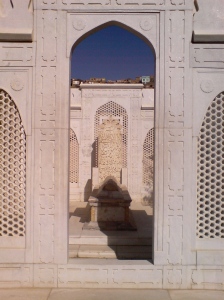A city that hurtles and rushes and bumps along as much as this one does needs little oases of relief to stop people from getting caught up by its vicious currents and unceremoniously washed away.
A precarious old man in dirty, trailing clothes, wobbles on an ancient bicycle across a hectic roundabout near the American Embassy. It is curious that he makes it through the mess of trucks and grinning boy-racers in Toyota Corollas and heavy armoured cars and donkey carts and skinny stall-sellers wheeling carts and fat-bottomed sheep grazing the rubbish. All bouncing around each other in random directions like some lethal school experiment in Brownian motion. Nothing about here is very much more organised, or less dangerous. There are a few oasis options, though…..
Look up and smug kites are wheeling, swooping and cheerfully cutting through the dusty air. This cat’s favourites are the frail-looking ones made of transparent plastic that you don’t see straight away; a shadow moving across the sun might catch the eye first of all. A man stands on his mud roof in the warming sun of the early morning, squinting at his kite and sending it skittering across the sky with tiny arm movements.
They look peaceful, the city’s kites, soaring above the earthbound confusion. Until you realise that they are also battling each other from the sky in a struggle just as vicious as anything going on below….
On Fridays, the nearby mosque burbles away, crackles of the microphone accompanying prayers and thoughts that this cat doesn’t understand, but the tones of which are relaxing. In Babur’s Gardens – Bagh-e Babur – on the western slopes of the Sher-e-Darwaza Mountain to the south of Kabul, families lay out rugs under fruit trees in the terraced orchard and drink tea. Small children toddle and somersault on the grass. Babur, who started the great, tolerant Mughal Empire which ruled India for 300 years, laid out the gardens, his favourite of the 10 he did around Kabul and the place, he decreed, in which he wanted to be buried. He missed Kabul; in India, there were, according to his memoirs, “no grapes, no musk melons, no first rate fruits or bread in its bazaars”.
Babur’s body was eventually brought back from Agra, where he died in 1530, to be buried in a roofless, white marble tomb, left open to the skies so that he could enjoy them.
A Persian inscription reads, “If there is a paradise on earth, it is this, it is this, it is this!”
Babur’s Gardens are definitely an oasis. The Aga Khan Trust for Culture restored them and, for the last month or so, their Queen’s Palace has also hosted an extraordinary collection of contemporary Central Asian art.
At Sherpur, just north-east of the middle of Kabul, there is a brown mud wall which the Afghan Government apparently put up in 1989 after the Russians had left. Inside the wall, another oasis: the Sherpur Christian Cemetery which the aid worker, Gayle Williams, liked so much that she decided that she would like to be buried there.
Oasis-wise, this cat, however, favours a hammock. Strung up between a hesco blast barrier and a tree, it gives a gentle swinging view of an enormous clear, cold blue sky.






November 2, 2008 at 11:36 am |
It sounds as though you are really in love with the place. The photographs are excellent.
November 2, 2008 at 4:43 pm |
o dear me no! what a horrifying – not to mention unfeline – thought…. oases are generally pleasant enough though…. and it would be a nice place for Christmas! A goose is on order, in case….